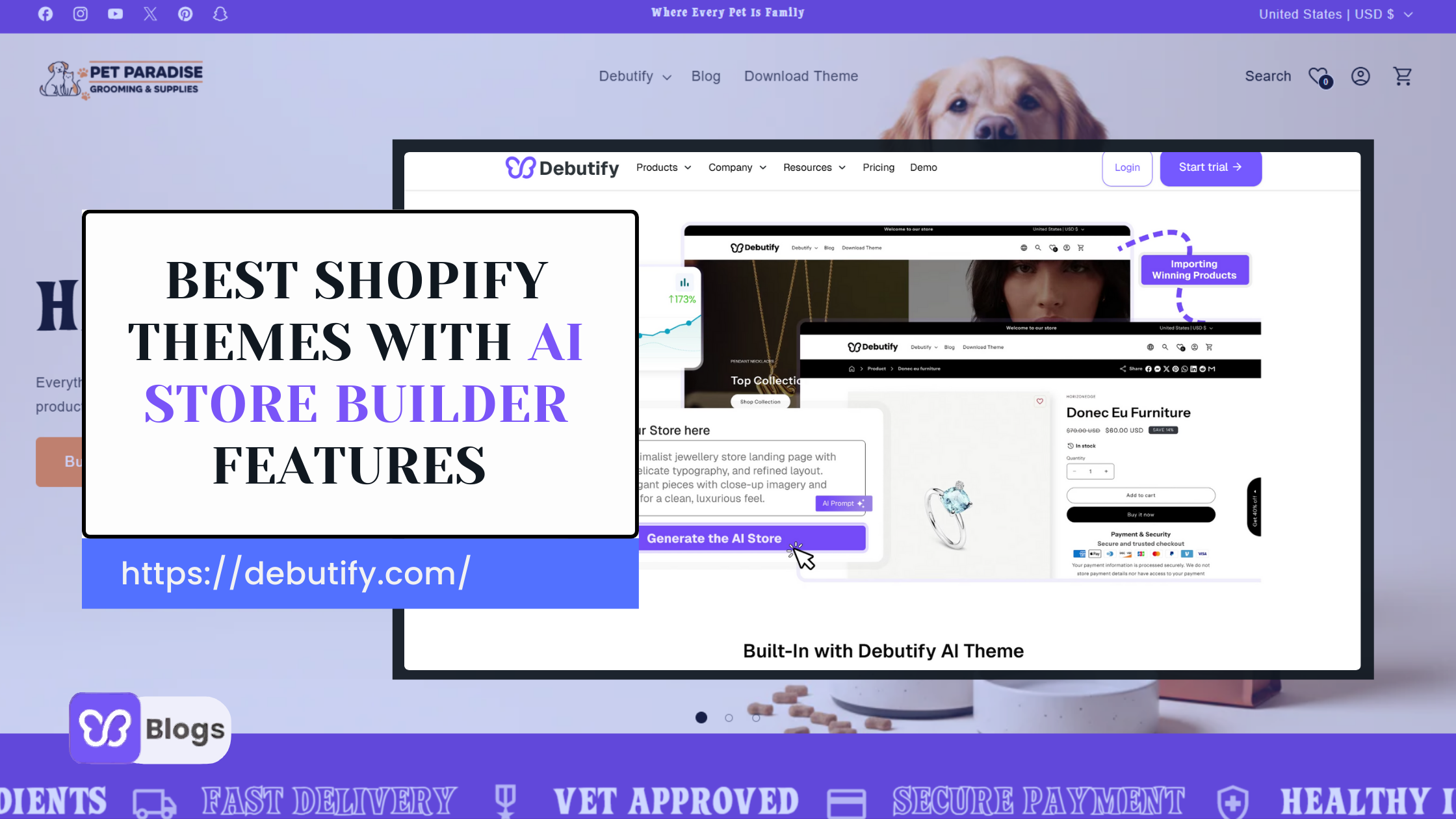Picture that: You have built a new store on Shopify after months of constant planning and research. You invested enough time deciding on your branding (colors/fonts/typography) and ensured your website encrypts data during payments to provide your customers with the most secure shopping experience.
Everything was exactly the way you wanted except for one thing. You find that your feature-rich store isn't as fast as you wanted it to be.
Can you expect your desired sales and conversions without optimizing your site for speed?
No.
Why? Because website speed is a critical factor for search engine rankings and conversion rate optimization.
A slow website not only impacts user experience but also increases your site’s bounce rate.
Research also reveals that ecommerce stores can lose up to 53% of their potential customers if their websites take longer than 3 seconds to load.
It's no surprise that the longer you hold your ecommerce store for speed optimization, the more buyers you'll lose to a faster rival's site.
We have created this page speed optimization guide to help new and expert sellers improve Shopify website speed for more leads and conversions.
What Is Page Speed?
Simply put, page speed is a measurement of how quickly content on your site pages loads. The term is often confused with the website speed, but both are two entirely different terms.
Site speed refers to the number of page views you get on your site, while Page speed indicates the total amount of time a particular page takes to load its content or the time a browser takes to receive the first byte of information from the server.
How Does Page Speed Impact Ecommerce?
Ecommerce store owners can use tools like Google Page Speed Insights to measure these scores.
According to research, 79% of buyers unhappy with the site's performance are less likely to buy from the brand again. The same research highlights that more than 64% of smartphone users prefer purchasing from a website that loads faster.
Crazyegg also highlighted that boosting a page speed by only one second can result in up to 7% more conversions.
It's no surprise that customers will never learn to cope with the slow website speed, and why should they? After all, there are thousands of brands offering the same products and services as yours. If a site takes longer than the customer's expectations, they have the option to click 'Back' and explore websites that offer a better user experience. You got that, right?
If you're using paid advertising, slow site speed can also ruin your Google Quality AdWords Score. As a result, you'll have to bear more cost-per-click.
SEO specialists and digital marketers also admit that slow page speed can impact your search rankings.
Why Is It Crucial To Improve Page Speed?
There are many reasons why page speed improvements make for a better customer experience. It results in more page views, curtails bounce rate, and improves your conversion rate.
Some other prominent benefits of Shopify website speed optimization include:
Improves User Experience
Loading time is one of the critical factors in website abandonment. Having a fast website helps build trust and positively contributes to the user experience.
Also, the first impression is the last. Even if you have the best content and eye-catching graphics on your site, all of your efforts will go down the drain if you fail to capture visitors' attention.
Improves Page Views
Your website is more likely to rank higher on search engines when you have a fast website. Google has also included load speed as one of its ranking factors a few years back. So, if you want to get more page views on your site, fast page load time can be your safest bid.
Improves Conversions
As mentioned above, fast load time builds trust. Also, customers feel more confident sharing their personal and billing information with sites that load faster and rank better on SERPs. All of this contributes to your conversion process, making it easier for ecommerce businesses to turn prospects into paying customers.
Reduces Bounce Rate
Slow website speed can significantly impact your bounce rate.
You'll witness lower conversion rates when most of your visitors leave your store without even exploring your site and internal pages. Having a fast website ensures your visitors spend more time on your website and complete the checkout process while enjoying the best user experience.
How To Optimize For Page Speed
1. Compress Images
One of the reasons your website speed is too slow is because of the large images embedded on your website. So make sure all images on your site are optimized and compressed.
Also, save images in the right format. PNG and JPEG formats can be compressed without any difficulty. Also, these formats are supported by all types of browsers.
According to research, HD images can be compressed by up to 80%.
Many online compression tools are available online that you can use to free up some space on your site so that your users can have the best user experience.
2. Choose A Light-Weight Shopify Theme Like Debutify
Not all Shopify themes are created alike. Especially when it comes to Shopify website speed, the performance may vary across different themes.
As a general rule, a good Shopify theme should not take 3.8 seconds to load. Debutify helps improve your site speed without needing you to compromise on design elements, navigation, and more.
Apart from that, we also ensure both your mobile and web users get to experience the same load speed.
If you think you have to write additional lines of code to get this job done, then we have good news for you.
Debutify is a one-click theme that allows you to offer the same user experience to your mobile and desktop users without having to write a single line of code.
Click on this link to download Debutify for free!
3. Use Fast Hosting
You get what you pay for. Hosting is one of the most critical yet often overlooked factors that impact your website speed. The good news is upgrading your hosting plan could improve your page speed.
There are four types of hosting plans available for ecommerce store owners:
Shared: As its name suggests, a single server hosts multiple sites. As many websites are using the same server, this option is relatively cheaper than other available options
VPS: While VPS hosts many sites at a time, each site has a dedicated spot
Cloud: Multiple websites are hosted on a network of servers (both virtual and physical)
Dedicated server: One server is dedicated to hosting a single website. If your budget allows, having dedicated hosting can be the best possible solution
4. Minify Your Code
You don't have to keep the HTML, CSS, and Javascript codes your developers have written for their convenience. The downside of having these codes is that they can reduce your site speed.
You can use tools like Microsoft Ajax Minifier, Google Closure Compiler, and more to minify these codes for you.
5. Reduce Redirects
Redirects can also negatively impact your Shopify website speed. Not only can redirects slow down your site speed, but they also hurt your search engine rankings. Instead of having plenty of redirects, it is better to leverage redirect functions that come with Shopify.
Similarly, get rid of all those broken links that are slowing down your site speed.
6. Use CDN
CDN, also known as Content Delivery Networks, is a network of servers that hosts your website locally to distribute the load of delivering content and improve page load times.
For example, if your user is accessing a website hosted originally in New York in France, they don't have to reach out to the server available in New York as they can access a closer one in France.
CDN saves multiple copies of your websites at different servers to lower the number of requests to the server of origin.
7. Limit Plugins And Reduce Third-Party Apps
With more plugins and third-party apps = a slow website
That is why it is essential to include only those elements that are actually important for your site's functionality. No, we're not asking you to remove all plugins as some of them can even help you out with the load speed improvement process, but get rid of everything else that is not adding any value to your site's functionality.
8. Use Browser Caching
Another effective tip to improve your website speed is to do it through browser caching. There are many elements involved that come into action when someone clicks on your website - images, page elements, and codes to name a few.
The same process repeats whenever someone tries to load your website. Browser caching remembers your previous loading resources to avoid loading them over and over again.
Whenever a user jumps from one page to the next on your site, bulky page elements like logo and header/footer do not need to load from scratch. As a result, your website will take less time to load and contribute to a positive user experience.
9. Leverage AMP
AMP stands for Accelerated Mobile Pages. It was originally introduced by Google to improve the mobile user experience. Since AMP allows you to use an open-source format to exclude plenty of unnecessary data and information, you'll witness improvement in your site speed in no time.
The purpose of introducing this project was to provide users with a more sophisticated and streamlined browsing experience on mobile devices. With AMP, your users don't have to click and wait for the next page to load. They can swipe from left to right or right to left to read the next/previous article.
Today, thousands of companies use AMP to improve their site's speed and reach their potential customers.
10. Prioritize Testing And Optimize For Mobile Performance
Having a winning mobile commerce strategy is essential for every ecommerce business today. More than 67% of sales were made on mobile devices during Black Friday Cyber Monday last year.
Also, the trend of mobile commerce isn't going anywhere in 2021 and beyond.
But did you know the number one issue cellphone users complain about is inconsistent user experience and slow site speed?
Your responsibility as an online seller is to test and optimize your website speed from time to time to ensure your customers get a consistent user experience throughout their journey.
11. Use Google Tag Manager To Streamline Your Tracking
Customer data fuels up your ecommerce marketing efforts. However many websites experience slow website speed while trying to collect valuable data from the users.
An all-inclusive Tag Management System condenses and organizes all your tags into one request. This gives your immense control over website management, as you'll have to remove a single tag only in case your site goes down.
12. Declutter Your Homepage
Go easy with your site's structure and design so that you don't have to make additional efforts to improve your Shopify website speed. Do not clutter your homepage with unnecessary sections, page folds, and enlarged images, as they can ruin your site speed and increase your bounce score.
Choose a simple homepage design with lots of CTAs to let your visitors know where they should head to proceed with the purchase.



